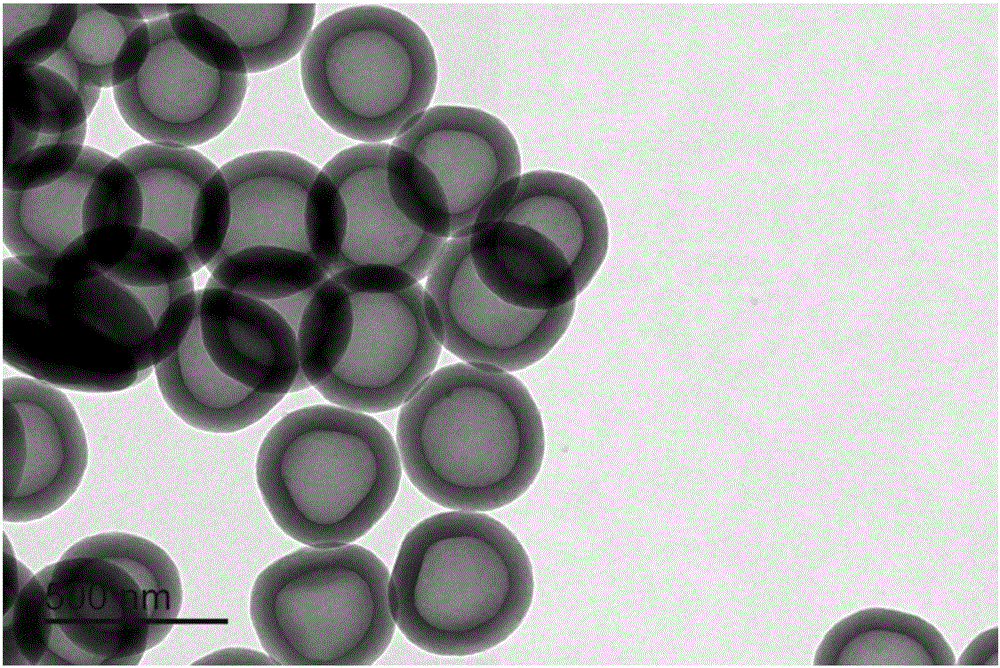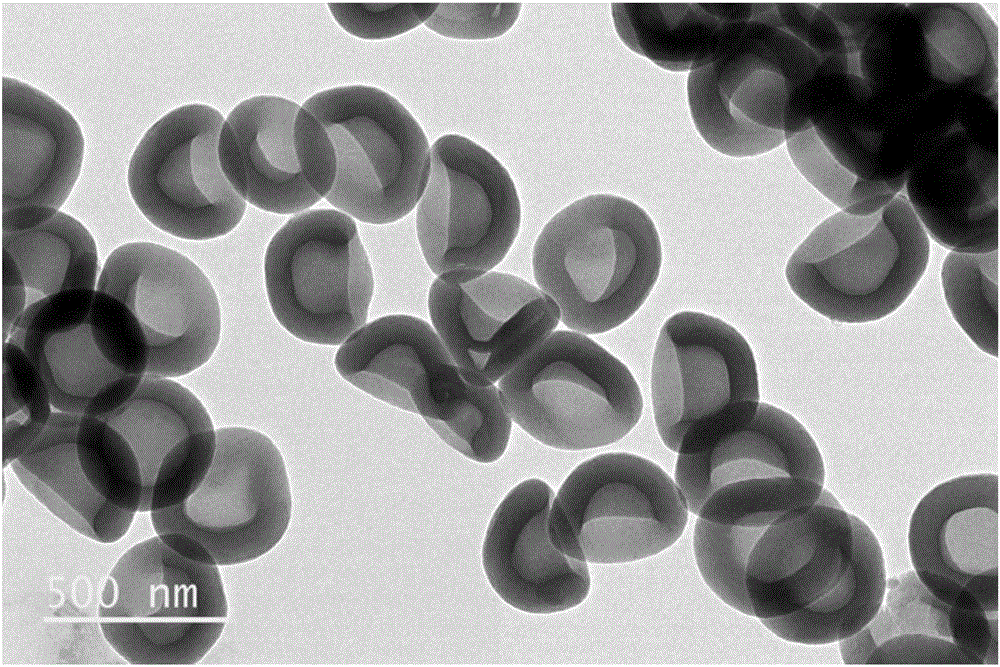Aminated polymer hollow nanomaterial preparation method
A technology of nanomaterials and polymers, applied in chemical instruments and methods, water pollutants, other chemical processes, etc., can solve problems such as low activity, complex synthesis, and inability of functional groups to exert their effectiveness effectively, achieving broad application prospects, High reactivity and fast preparation
- Summary
- Abstract
- Description
- Claims
- Application Information
AI Technical Summary
Problems solved by technology
Method used
Image
Examples
Embodiment 1
[0023] Step 1: Accurately measure 280ml of ethanol and 70ml of deionized water to prepare a mixed solution, add 5ml of ethylenediamine, stir magnetically for 30 minutes, quickly add 14ml of TEOS (tetraethyl orthosilicate), stir vigorously for 10 minutes, then add 2g of m-benzene Diphenol, after the resorcinol is dissolved, add 2.8ml formaldehyde, adjust the reaction temperature to 30°C, and react for 24h. Subsequently, the prepared nanospheres were centrifuged and dried in an oven at 100°C.
[0024] The second step: at room temperature, put the prepared nano-spheres into 1% hydrofluoric acid for desiliconization treatment, centrifuge the material, and dry it in an oven at 100°C to prepare the aminated polymer hollow nanospheres.
Embodiment 2
[0026] Step 1: Accurately measure 405ml of ethanol and 133ml of deionized water to prepare a mixed solution, add 10ml of ethylenediamine, stir magnetically for 30 minutes, quickly add 7ml of TEOS (tetraethyl orthosilicate), stir vigorously for 5 minutes, then add 2.5g of Hydroquinone, after the resorcinol is dissolved, add 3.5ml formaldehyde, adjust the reaction temperature to 30°C, and react for 24h. Subsequently, the prepared nanospheres were centrifuged and dried in an oven at 100°C.
[0027] The second step: at room temperature, put the prepared nano-spheres into 12% hydrofluoric acid for desiliconization, then centrifuge the materials, and dry them in an oven at 100°C to prepare the aminated polymer hollow nanospheres.
Embodiment 3
[0029] Step 1: Accurately measure 532ml of ethanol and 266ml of deionized water to prepare a mixed solution, add 5ml of ethylenediamine, stir magnetically for 15 minutes, quickly add 7ml of TEOS (tetraethyl orthosilicate), stir vigorously for 10 minutes, then add 2g of m-benzene Diphenol, after the resorcinol is dissolved, add 2.8ml formaldehyde, adjust the reaction temperature to 70°C, and react for 48h. Subsequently, the prepared nanospheres were centrifuged and dried in an oven at 100°C.
[0030] The second step: at room temperature, put the prepared nano-spheres into 10% hydrofluoric acid for desiliconization treatment, then centrifuge the materials, and dry them in an oven at 100°C to prepare the aminated polymer hollow nanospheres.
PUM
| Property | Measurement | Unit |
|---|---|---|
| adsorption capacity | aaaaa | aaaaa |
| adsorption capacity | aaaaa | aaaaa |
Abstract
Description
Claims
Application Information
 Login to View More
Login to View More - R&D
- Intellectual Property
- Life Sciences
- Materials
- Tech Scout
- Unparalleled Data Quality
- Higher Quality Content
- 60% Fewer Hallucinations
Browse by: Latest US Patents, China's latest patents, Technical Efficacy Thesaurus, Application Domain, Technology Topic, Popular Technical Reports.
© 2025 PatSnap. All rights reserved.Legal|Privacy policy|Modern Slavery Act Transparency Statement|Sitemap|About US| Contact US: help@patsnap.com



